Papaver nudicaule



Stemless / Acaulescent
A plant that has no stems, when the flower stalks and leaf blades are produced from ground level.
Spreading-ascending
When a plant has stems that gradually grow upwards.This perennial is commonly grown as an annual and forms a rounded tufted habit. It has dark green lobed leaves and arise from a crown. The red, orange, yellow and pink cup-shaped flowers appear solitary above the foliage from late autumn to early spring.
Papaver nudicaule is naturally found from Iceland to the sub-arctic regions growing on rocky hillsides and lowlands. It grows in poor to moderately fertile well drained moist to dry light loams that are acidic to neutral with a pH range from 5.5 to 7.5 but tolerates chalky soils. It prefers an open sunny position and is frost tolerant but drought tender and deer resistant. It can be an annual, biennial or herbaceous perennial.
The Iceland Poppy is grown for its flowers and is planted in small or cottage gardens along perennial borders. It is also used in bedding displays for large gardens or is planted in patio pots or tubs. It establishes in one season and is commonly grown as an annual. As a cut flower pick early in the morning, scald stems for 15 seconds before placing in fresh water. Once established it has a medium water requirement, (Scale: 2-drops from 3) and responds to mulching with regular deep watering during dry periods.
I.D. 200
UK hardiness zone H7
Climate zones A2, A3, 1-6, 7-9, 12 - 24
USDA Zone 2-10
Papaver (pa-PAH-ver) nudicaule (new-de-KAW-lee)
'Papaver': Latin name for the poppy; 'nudicaule': naked stem.
There are many cultivars of this plant contact your local nursery for available varieties.
Cultivars
'Artists Glory'
This perennial grows to 500 mm (20 in) and produces large flowers in pastel, pink, red, white, yellow and orange.
'Champagne Bubbles' F1
This perennial grows to 500 mm (20 in) and produces large flowers in many colours and bi-colours.
'Coonara'
This perennial grows to 400 mm (16 in) the flowers are in pink shades and smaller.
'Lustrous Giants'
This perennial grows to 500 mm (20 in) and produces large flowers in pastel colours and strong colours.
'Rimfire'
This perennial grows to 400 mm (16 in) and produces scarlet flowers and scarlet stamens.
F2 Hybrid
'Springsong'
This perennial grows to 500 mm (20 in) and produces large flowers.
'Summer Promise'
This perennial grows to 500 mm (20 in) and produces large flowers in a mixture of colours.
Papaveraceae (pa-pav-er-AY-see-ee)
Poppies
This family consists of herbs that are normally annual or perennial. The species are readily distinguishable by their distinctive flower shape and the stems and branches contain milky-like latex that may be clear.
Distribution
This family of plants is mainly found in the temperate regions of the northern hemisphere with a few species in the southern hemisphere.
Diagnostic Features
The leaves are arranged radically or alternate with stipules absent. The margins are toothed, lobed or dissected.
The regular flowers are bisexual and are solitary occurring in the leaf axils. There are 2 sepals and may be connate to the calyptra and fall off when the flower opens. There are 4 to 6 petals that are imbricate.
There are numerous stamens that are free. The ovary is superior with a sessile stigma on top and numerous ovules attached to the wall of the ovary
The fruit is a capsule, dehiscing by pours or valves releasing small seeds that have endosperm.
Note:
There are many colourful species that are cultivated in gardens. There are 200 species worldwide with 13 species in Australia none of which are endemic.
This plant tolerates between USDA zones 2a to 10a and grows to 0.7 m (2 ft)
Fahrenheit -50º to 35º F
These temperatures represent the lowest average
Celsius -42.8º to 1.6º C
Attention
All photographs and data are covered by copyright. Apart from any fair dealing for the purpose of private study, research, reference or review, as permitted under the Copyright Act, no part may be reproduced by any means with out written permission. All inquiries should be addressed to plantfile.com attention Peter Kirkland.

Simple
The leaf that is not divided.
Lobed
A leaf that is rounded and forming incomplete divisions from the margin to the centre.
Rosette
A cluster radiating from a common source.
Pinnatisect
A leaf margin or shape that is almost pinnate with lobes reaching the mid rib but not forming definite leaflets.
Crateriform
A saucer shaped hollow.
Solitary
When a flower that arises singly from within the axis of a leaf or terminally.| Jan | Feb | Mar | Apr | May | Jun |
| Jul | Aug | Sep | Oct | Nov | Dec |
The 120 mm (4 ¾ in) wide cratiform flowers have 4 to 5 broad petals with a cluster of prominent stamens in the centre. They are held high above the foliage on an un-branch scape that is up to 500 mm (20 in) tall and appear during spring. The flower buds are enclosed by a pair of pubescent sepals and the flower colour ranges from white, pink, red, orange, yellow and bi-colours.

Capsule
A dried dehiscent fruit, with an enclosing membrane normally containing may seeds."The Iceland Poppy is grown for its flowers and is planted in small or cottage gardens along perennial borders.It is also used in bedding displays for large gardens or is planted in patio pots or tubs. It establishes in one season and is commonly grown as an annual. As a cut flower pick early in the morning, scald stems for 15 seconds before placing in fresh water.
Note:
This plant is susceptible to Spotted Wilt Virus and Peanut Root Nema.
Sow fresh seed during late summer to autumn in flats or boxes, and prick out when 10mm to 40 mm (1 5/8 in) tall. It takes 4 months to flowering from sowing and when planting leave crowns clear of the soil.
Propagation by Seed (General)
Germination
In order for a seed to germinate it must fulfil three conditions.
1. The embryo must be alive (a viable seed).
2. The seed must have no dormancy-inducing physiological, physical or chemical barrier to germination; also the seed must be nondormant.
3. The seed must have the appropriate environmental requirements, water, temperature and oxygen.
The interaction between these requirements and dormancy is complex and may lead to different environmental requirements that avoid the dormancy of a seed.
Sowing Seeds in Containers
There are two general methods for germinating seeds.
1. Sowing seeds in a flat or germinating bed, through which seedlings are pricked-out then, transplanted into another flat with wider spacing or directly to an individual pot.
2. Sowing seeds by placing them in to flats with the appropriate spacing or into individual pots.
This method is normally carried out with medium to large seeds such as woody plants and plants that are difficult to transplant.
Seedling production normally occurs in a greenhouse / glasshouse, cold frames and on hot beds.
Method of Seed Sowing
Fine seed is sown in pots or flats that are no deeper than 70 to 80 mm. using a sterilised well-drained media (soil). Fill the container to 20 mm from the top and sprinkle sieved peat to 3 mm depth.
Press the media down level and firm with a piece of timber and then thoroughly moisten.
Mix the fine seed with washed sand and then sow thinly on the surface. These may be lightly covered with sand.
Larger seeds may be covered with media or a hole is dibbled and the seed is placed in the media.
Watering Methods
For watering you may either mist the containers from above or place the container in tepid water and allow the water to raise through the pot to the surface of the media, then drain away and do not fill to the top of the container.
Place a piece of glass over the pot and store in a protected warm environment (glasshouse).
Seeds germinate best in darkness so shade the containers if in direct sunlight.
After the seedlings have sprouted remove the glass and ease the seedlings into direct light.
When the seedlings are large enough prick them out and transplant into larger containers then place them in a shade house to harden off.
Many seeds have different methods of seed preparation for germination such as nicking or cutting the seed coat to allow water penetration, also placing seeds in hot water and allowing it to cool off.
This is particularly important as it is softening the seed coat.
PEST
NAME
Aphids
Various Aphid Species
ORDER
Hemiptera
FAMILY
Aphididae
Description of the Pest
The common name varies and aphids may be referred to as black fly, greenfly, ant cows or plant lice.
These small insects have soft globular body that is from 1mm to 8mm long and vary in colour from green, yellow, black and pink, with the winged forms being elongated. Both adult and nymphs, have piercing and sucking mouthparts.
Aphids are found on buds, flowers, or leaves and stems, preferring soft new growth. On older leaves the aphids are found in protected positions, such as under the leaf. Certain species of aphids form galls as they suck sap and may be found on the roots of the plant. (E.g. Woolly aphids and Black peach aphids)
Most aphids possess a pair of characteristic tubular projections, known as cornicles; these secrete a pheromone and a waxy fluid, which is thought to protect them from some of their predacious enemies.
White exoskeletons, honey dew and sooty mould indicate the presence of Aphids
Balsam Twig Aphid (Mindarus abietinus) is greenish and covered in a white wax and is normally found on the young shoots of conifers bending and killing the needles. It is found on Abies and Picea species.
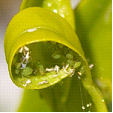 Aphid and their exoskeletons
Aphid and their exoskeletons 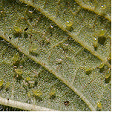 on underside of a leaf
on underside of a leaf
Black Citrus Aphid (Toxoptera aurantii) has a soft plump green body and the black coloured adults may or may not be winged. They feed in groups, curling leaves and producing honeydew attracting sooty mould.
Green Peach Aphid (Myzus persicae) is a soft plump green insect up to 0.2mm long and may be wingless. The nymphs are yellowish green and are responsible for spreading viruses in Dianthus species.
Spruce Gall Aphid (Chermes abietis) form cone shaped galls up to 12mm long resulting from the feeding. The wingless female adult lays eggs on the stems and the immature females overwinter on bud scales. Large infestation will weaken trees such as Picea abies and Pseudotsuga menziesii.
Tulip Bulb Aphid (Anuraphis tulipae) is small, waxy grey coloured and infests the underside of the bulb scales or rhizomes. They occur in the ground or on above ground parts and during storage.
Life Cycle
These insects have a Hemimetabolous life cycle, i.e. The nymphs resemble the adults.
During spring all eggs produced hatch as female nymphs. Adult Aphids are capable reproducing without fertilisation. The males are only produced in some species as the weather cools down, and the day length shortens.
Aphids are capable of giving birth to living young and large populations build up quickly during summer. Over crowding causes the aphids to become smaller, less fertile and produce more winged forms that can migrate to other host plants.
There are many different types of aphids and the life cycle varies from warm to cold climates.
Typical life cycles

Distribution of the Pest
World wide
Period of Activity
In warm climates they are seen throughout the year, but aphids dislike hot dry or cold conditions and heavy rain will decrease the population. In cold areas aphid eggs are laid around a bud base or other protected areas of the plant during autumn and emerge as nymphs during spring, feeding on the new growth.
Numbers build up quickly in the warmer months of the year. Some species feed during winter on Sow thistles.
Susceptible Plants
There is a wide range of plants attacked, from roses to vegetables, shrubs and trees. Certain aphids attack a specific genus while others have a wide range of host plants. Many are capable of transmitting plant virus diseases.
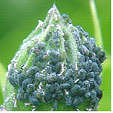 Adults and nymphs feeding
Adults and nymphs feeding 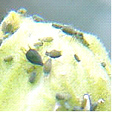 A colony of aphids
A colony of aphids
Acer species are attacked by several aphids including the Norway Maple Aphid (Periphyllus lyropictus) which is a greenish with brown markings and secret honeydew, preferring Acer platanoides. Other aphids include (Drepanaphis acerifolia) and (Periphyllus aceris) which are commonly found on the underside of leaves.
Acer species are also attacked by the Woolly Maple Aphid (Phenacoccus acericola) which covers the undersides of the leaves with a cotton-like mass
Alnus species are infested with the Alder Blight Aphid (Prociphilus tessellates) which is blue-black adult that forms woolly masses on the down-turned leaves. The nymphs overwinter in bark crevices.
Aquilegia species are attacked by several aphids including (Pergandeidia trirhoda) which is a small, flat cream coloured insect that is found on young branches and the underside of leaves.
Betula species may be attacked by the European Birch Aphid (Euceraphis betulae) which is small and yellowish or the Common Birch Aphid (Calaphis betulaecolens) which is large and green producing ample honeydew for sooty mold to grow on.
Callistephus species may be attacked by the Corn Root Aphid (Anuraphis maidi-radicis) causing the plant to become stunted, the leaves wilt and turn yellow. The aphids feed on the roots producing honeydew and are dispersed to other host by ants. It is also attacked by the Potato Aphid (Macrosiphum solanifolii).
Carya species are attacked by Gall Aphids (Phylloxera caryaecaulis) which is found on the leaves, twigs and stems forming galls and turning them black.
Chaenomeles and Gladiolus species, new growth and leaves become infested with the aphid (Aphis Gossypii)
Cupressus macrocarpa may become infested with the Cypress Aphid (Siphonartrophia cupressi).
Cyclamen species are attacked by the aphid (Myzus circumflexus) and (Aphis gossypii) which can infest healthy plants.
Dendranthema, Dianthus and Crocus species are attacked by several types of aphid including the Green Peach Aphid (Myzus persicae) and the Chrysanthemum Aphid (Macrosiphoniella sanborni).
Hibiscus species are attacked by the aphids (Aphis craccivora) and (Aphis gossypii), both congregate towards the branch tips and may cause leaf curl. Normally only seen in sub-tropical climates.
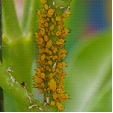 Aphids on a stem
Aphids on a stem 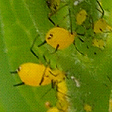 Mandevilla species
Mandevilla species
Larix species is attacked by the Woolly Larch Aphid (Adelges strobilobius). The winged adults deposit eggs at the base of the needles during spring and white woolly areas appear attached to the needles where the adult aphids feed. The young aphids overwinter in the crevices of the bark.
Mandevilla species is attacked by aphids that congregate towards the branch tips and may cause leaf curl.
Pinus species is attacked by several species of aphid including Pine Bark Aphid (Pineus strobi), Pine leaf Aphid (Pineus pinifoliae) and the White Pine Aphid (Cinara strobi).
Primula species are attacked by four species of aphid including foxglove, and green peach aphid.
Rudbeckia, Delphinium, Chrysanthemum and Helianthus species are attacked by a bright red aphid (Macrosiphum rudbeckiae).
Sorbus aucuparia is affected by the Rosy Apple and Woolly Apple aphid which attacked the foliage and young shoots.
Spiraea species are attacked by the Aphid (Aphis spiraecola) which feeds on the young shoots and flowers.
Tropaeolum species are attacked by the Black Bean Aphid (Aphis fabae), which is found in large numbers on the underside of the leaves, turning them yellow and causing them to wilt then die.
Tulipa, Iris, Freesia, Gladiolus and Zephyranthes species are infested with the Tulip Bulb Aphid.
Ulmus species are infected by two types the Woolly Apple Aphid (Eriosoma lanigerum), which curls and kills young terminal leaves and the Elm Leaf-Curl Aphid (Eriosoma ulmi) which occasionally attacks the trees.
Viburnum species are attacked by the Snowball Aphid (Anuraphis viburnicola). This aphid congregates at the end of the branches causing the leaves to curl and become deformed under which they hide.
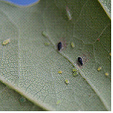 Aphids on Quercus robur
Aphids on Quercus robur
Damage Caused
Buds that have been attacked may not open, leaves and twigs become twisted or distorted and wilt. The aphids also produce honeydew, which is sticky and attracts sooty mould (fungus). This fungus forms a thick layer over the leaf, fruit or stems reducing the plants photosynthesis capability. The sooty mould spoils the plants appearance and its fruit, as does the insects white exoskeletons.
Control
Cultural Control
Aphids may be removed from a plant by hosing them off with water (limited success) or applying soapy water to aphids.. Another organic sprays can be efficient in controlling aphids. Aphids may also be removed physically by hand for small colonies on spine less plants. Species that live under ground are difficult to control but cultivation of the surrounding soil may help in controlling the infestation. (limited mainly to annual or commercial crops)
Reflective mulch around the plants also reduces numbers by repelling the insect this material is available commercially. (Reflective mulches are mainly used in market gardens for avoiding the Green peach Aphids) Resistant rootstocks are available to avoid some root feeding aphid of commercial plants, e.g. Vines and fruit trees
Biological control
Aphids are attacked by several insects includes parasitic wasps or predators such as ladybirds/ lady beetles, hover flies, lacewings, spiders.
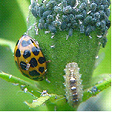
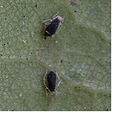 Parasitised aphids
Parasitised aphids
Chemical Control
Aphids may be controlled by spraying with a contact or systemic insecticide. The type of application used will depend on the plant is being attacked.
Aphids can be suffocated and therefore controlled with the use of e.g. White oil, Pest oil, Soapy water from soap such as Lux Flakes ®
Note
It is your responsibility by law to read & follow the directions on the label of any pesticide
Monitoring
Aphid are attracted by yellow colour and traps such as boards painted yellow and covered in glue or sticky substance will attract and trap the insects. There is also a commercially sticky yellow tape that can be attached to susceptible plants
Amendments by B. Sonsie Dip Hort Sc Burnley
DISEASE
NAME
Bacterial Rot
Various Bacterial Species
Description
Bacterial problem associated with water soaked strips on the leaves, stem, roots, fruit or flower. Bacterial wilts produce causative slime that clogs the water-conductive tissue of a plant.
Symptoms
Bacterial Blight (Pseudomonas mori) forms water soaked spots on the leaves and shoots, becoming sunken and turning black causing the leaves and twigs to wilt and die.
There is also a Bacterial Blight (Pseudomonas syringae pv pisi) that infects legumes during humid weather with water soaked spots on the leaves and stems near the base. The spots become dark and as the stem shrivels, yellow lesions appear. Leaves and fruit pods turn brown and die.
Bacterial Leaf Spot (Pseudomonas viburni) forms wet spots that enlarge becoming brown and sunken. These spots can be seen on the leaves and young stems and the bacteria overwinter in buds or in cankers. It is found on Viburnum species.
Bacterial Wilt (Xanthomonas species) infects palms causing the lower fronds to wilt then turn grey-brown and die. This is followed by the crown becoming spongy (rotted) attacking the vascular tissues and eventually causing the collapse of the crown. There is also a Bacterial Leaf Spot (Xanthomonas species) that causes spots on leaves with water-soaked margins and is found on Alocasia species.
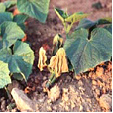 Bacterial Wilt
Bacterial Wilt
Bacterial Wilt (Pseudomonas solancearum biovar 1 and 3). This disease initially turns the youngest leaves pail-green to yellow; they then wilt turn brown and die. It eventually affects the entire plant and is found on Heliconia species.
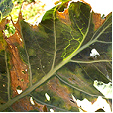
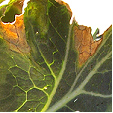 Black Rot or Bacterial Wilt
Black Rot or Bacterial Wilt
Black Rot or Bacterial Wilt (Xanthomonas campestris) is a bacteria rot that infects the leaves and seedlings of Cruciferous vegetables causing 'V' shaped pale yellow blotches to appear, normally infection occurs along the margin of the leaf or through damaged areas of the leaf. It also causes the flower head to become stunted and the veins or water conducting tubes in the leaves and stems to turn brown or blackish. Heavy infections cause the plant to wilt and die.
Bud Rot (Xanthomonas cannae) infects young leaves and flower buds of Canna species, killing them. Small whitish spots appear as the leaves or buds open, these enlarge then run together turning black. The symptoms also extend to the petioles and stems forming yellowish water soaked areas and the bacterium overwinters in the rhizomes.
Halo Blight of Beans (Pseudomonas syringae pv phaseolicola) forms water soaked or greasy angular spots on the pods or stems of the host. This causes the plants to yellow and become stunted. During humid weather a white slime is exuded from the damaged areas.
Soft Rot (Pecotbacterium carotovorum) affects bulbs, initially stops flowers from blooming or forming correctly. These flowers are shed, and the plant rots at the base causing it to collapse. On inspection of the bulbs a white foul smelling viscous smell is associated with a soft rot.
Wetwood (Erwinia nimipressuralis) causes wilting and branch dieback in Ulmus species. The wood forms dark water soaked areas with no obvious streaking in the outer sapwood.
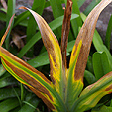 Yellow Rot in Iris
Yellow Rot in Iris
Yellow Rot (Xanthomonas hyacinthi) is a bacterial disease infects the cell walls of the leaf, stem and bulbs and caused yellowish water soaked areas to appear. These areas become brown and shrivel, or pockets of rot appear, soon engulfing the entire bulb. The disease may start from the leaf down or from the bulb up infecting the whole plant. A cross section reveals vascular tissue that is choked with yellowish slime. Infected plants soon brown off, collapse and die.
Source and Dispersal
The bacterium is found in infected plant material and not necessarily the soil and is spread by splashing water, wind or infected stock.
Favoured Conditions
It prefers warm moist conditions normally during spring.
Affected Plants
These bacteria attack many plants including; onions, Hyacinth species and its varieties, this can be a major problem in bulb nurseries.
Vegetables such as potatoes are also infected by blight which forms dark brownish spots on the leaves that become larger, eventually killing them and followed by lesions on the stems. The roots are infected by falling spores and peas suffer from a bacterial blight that forms spongy leaves with dark brown edges. The leaves and stem shrivel and die.
 Strelitzia nicolai
Strelitzia nicolai
Archontophoenix and Strelitzia species are susceptible to the Bacterial Wilt (Pseudomonas solanacearum). The leaves become yellowish and brownish along the margins causes the fronds to wilt and dry out. The vascular tissue in the stems then becomes blackish and the plant dies prematurely.
Berberis species are infected by the Bacterial Leaf Spot (Pseudomonas berberidis) forming irregular dark green water soaked areas that turn purplish brown. It also infects young shoots and petioles or damaged areas.
Bougainvillea and Limonium species are infected by the Bacterial Leaf Spot (Pseudomonas andropogonis) which forms orange angular spots that are lighter in the centre and cause the leaves to fall prematurely. It is most common in tropical regions.
Caryota mitis (Clumping Fish Tail Palm) is infected by the Bacterial Blight (Pseudomonas avenea). The symptoms include water soaked translucent areas along the leaf veins that mature to brown then black with a chlorotic halo that is up to 2 mm wide by 50 mm long. Leaves of all ages are infected and immature leaves are more severely infected.
Control methods include eliminating overhead watering, removing infected foliage and improve air circulation around the plant.
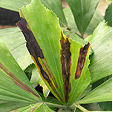 Caryota mitis
Caryota mitis
Cheiranthus species and other plants in the Brassicaceae family are infected by the Bacterial Wilt (Xanthomonas campertris) causing the leaves to wilt, turn yellow and die. It also stunts the inflorescence and turns the phloem and xylem blackish. Other plants that are infected include, Arabis, Armoracia, Aubrieta, Brassica, Hesperis, Iberis, Lobularia and Mathiola species.
Corylus species are infected by Blight ((Xanthomonas corylina) that attacks the leaves and branches.
Delphinium species are infected by several leaf spots including the bacterial disease Black Leaf Spot (Pseudomonas delphinii) which produces irregular tar-like spots on the upper surface of the leaf with corresponding brownish areas on the underside. This infection may extent down the petiole to the twigs. It normally occurs during cool weather affecting the lower leaves first.
Dianthus species are infected by the Bacterial Wilt (Pseudomonas caryophylli) which turns the leaves greyish, then yellowish before dieing. Yellowish streaks are also seen on the stems.
Dieffenbachia species are infected by two Bacterial Leaf Spots (Erwinia species) and (Xanthomonas campestris pv. dieffenbachiae). Both form yellowish spots that turn brown on the leaves that have water-soaked margins.
Eschscholtzia species are infected bt the Bacterial Blight (Xanthomonas papavericola) which forms tiny black spots that are water soaked and may be ringed.
Euphorbia pulcherrima is infected by Bacterial Canker (Corynebacterium poinsettiae) which forms streaks on the green stems that are water-soaked. The leaves may also be affected producing spots or blotches.
Gladiolus, Crocus and Freesia species are susceptible to Bacterial Scab (Pseudomonas marginata). This disease attacks the corms by forming slightly raised yellowish lesions that develops a raised rim with a soft sunken centre, producing bacterial exudate. It also infects the leaves with small reddish spots appearing towards the lower part. These spots merge and destroy the basic cell structure (parenchyma tissue) in the petioles causing the leaves to fold downwards, eventually killing the plant.
Hedera helix is susceptible to the Bacterial Leaf Spot or Stem Canker (Xanthomonas hederae). This infection commences with pale green water soaked spots or areas appearing on the leaves. These areas than become brown-black and dry with reddish margins, eventually engulfing the leaf causing it to shrivel. The bacterium then extends along the twigs and into the stems causing cankers. Several Fungal leaf spots develop simular symptoms and may be difficult to distinguish the difference. Generally avoid high humid temperatures and water plants at the base.
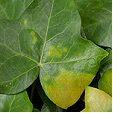
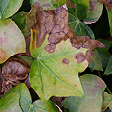
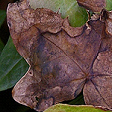 Hedera helix
Hedera helix
Morus species are infected by Bacterial Blight (Pseudomonas mori).
Orchids such as Cattleya, Cymbidium, Cypripedium, Dendrobium, Epidendrum, Oncidium, Paphiopedilum, Phalaenopsis and Zygopetalum species are infected by Bacterial Brown Rot (Pseudomonas cattleya) which forms water-soaked leaf spots that turn brown. Phalaenopsis species are particularly susceptible.
Caryota species are susceptible to Bacterial Leaf Blight (Pseudomonas albopercipitans). This disease forms elongated water soaked areas on the fronds that are translucent at first becoming blackish.
Roystonea regia, Cocos nucifera and Phaseolus species are infected by Bacterial Wilt (Xanthomonas species).
Tropaeolum species are infected by Bacterial Leaf Spot (Pseudomonas aptata) forming spots and rotting the leaves. They are also infected by the Bacterial Wilt (Pseudomonas solanacearum) which gains access through damaged roots or through the stomates, causing yellowing, wilting and the death of the plant.
Zinnia species are attacked by Bacterial Wilt (Pseudomonas solanacearum).
Non-chemical Control
Remove and destroy any infected plants. As a preventive measure cultivate the surrounding soil to improve drainage, aeration and minimise weed growth. Do not over water and allow the soil surface to dry before rewatering. When handling the plants pick a dry period and take care to minimise damage.
At first sigh of infection the plant should be removed and disposed off and avoid replanting susceptible vegetables such as peas for up to three years.
Chemical Control
There is no satisfactory chemical control. It is important to take preventive measures.
Note
Always read the label for registration details and direction of use prior to application of any chemicals.
DISEASE
NAME
Sclerotinia Rot, Crown Rot
Sclerotinia species
Description
A fungal problem that attacks plant parts causing them to collapse and rot, including flower, leaf and stems.
Symptoms
This fungus attacks all the above ground parts of the plant but commonly infects the stem at the base, where it forms a soft, light brown watery rot that spreads rapidly. Under humid conditions the rotted areas forms white fluffy mycelium on which black sclerotia up to 10mm long develop. These sclerotia also form within the stem in affected areas. When leaves are infected the tissue may brown and dry out, especially during arid conditions. The resulting affect of infection is the death of the plant.
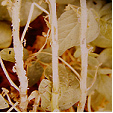
Image by B. Sonsie
Crown Rot (Sclerotium delphinii) causes leaves to turn yellow then become dry, and blossoms to wilt eventually killing the entire plant. It is found on Scilla, Viola and Delphinium species.
Flower Blight (Sclerotinia camelliae) infects flowers either by attacking the top of the petals forming brown specks or at the base of the flower where the petals turn brown then fall with out any sign of rot. The fungus develops on the fallen petals where microconidia are produced under moist conditions and eventually sclerotia appear. This form of the fungus can overwinter either above or below soil level until favourable conditions occur, then the spores are released and dispersed by wind.
Source and Dispersal
Sclerotia are found in the soil or on other infected plants and released spores are dispersed by wind.
Favoured Conditions
Prefers cool moist conditions with temperatures from 10º to 25ºC and is more common from autumn to spring when it is wet.
Affected Plants
A wide range of plants can be infected included French beans, peas, celery, cabbage, cauliflowers, carrot, parsnip, dahlia stocks, primula and many weeds.
Actinotus, Dampiera, Westringa species and Helichrysum bracteatum are infected by the Crown Rot (Sclerotinia rolfsii). Basial rot of the plant with cottony fungal growth and is associated with root congestion. Certain species of orchid may also be attacked.
Allium species are infected by the White rot (Sclerotium cepivorum) which is a major fungal disease of plants.
The bulb rot and are covered in mycelial which develop small black sclerotia (fruiting bodies) and infected plants may fail to produce flowering stem with the leaves become covered in a white mould, turning yellow then dieing off. It is commonly transmitted by infected seedlings and diseased plants should be burnt. Avoid re-planting Allium species in the infected soil where the spores overwinter. Soil may be infected for several years.
Antirrhinum, Aquilegia, Lobularia and Mathiola species are attacked by the Stem Rot (Sclerotinia sclerotiorum ) which infects the stigma travelling downwards through the flower into the stem where water soaked areas appear causing it to collapse. The flowers become pale and the entire plant may collapse. On inspection flat sclerotia may be seen in the stem.
Camellia species may be infected by Flower Blight (Sclerotinia camelliae) which causes blooms to fall and Stem Rot (Sclerotinia sclerotiorum).
Hyacinthus species can be infected by the fungus Black Slime (Sclerotinia bulborum) that causes the leaves to turn yellow then fall and bulbs to disintegrate.
Iris species are infected by the fungus Rhizome Rot (Botryotinia convoluta) that infects the rhizomes and forms black sclerotia, and is normally found on dieing plants during spring.
Turf Grass in warm climates is susceptible to Rolf's Disease (Sclerotinia rolfsii). The fungus infects the turf causing isolated dead patches up to 450mm across from spring to summer. As it progresses the dead patches increase in size and the white cotton-like mycelium can be seen in the underlying soil. It is not regarded as a major problem, with minor attacks on Cynodon dactylon (Couch) and Zoysia species.
Non-chemical Control
Initially remove and destroy any infected plants, when replanting, avoid using susceptible crops for 3 years. Space the plants to reduce the humidity and airflow and cultivate the soil to increase the drainage. Remove weed growth and leaf or flower litter from around the base of the plants to reduce the development of spores
Turf Grass culture such as aerating soil and maintaining a neutral pH helps prevent infection of Rolf's Disease.
Chemical Control
No suitable fungicides available, though drenching or spraying the soil with the fungicide dichloran helps control it.
DISEASE
NAME
Downy Mildew (General)
Various Downy Mildew Species
Description
Generally Downy Mildew may occur as a result of several fungal species, but have simular symptoms. The fungus is normally host specific.
Symptoms
The upper leaf forms yellowish, green or translucent patches that become enlarged and eventually the leaf turns yellowish-brown, wilts and dies. It can extend down the petioles onto the plant causing it to collapse and on the underside of the patches downy spores form, these may be grey to mauve or brown to purplish.
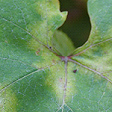
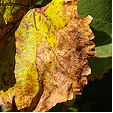
The Downy Mildew (Plasmopara halstedii) forms pale green spots on the upper surface of the leaves with corresponding white felty areas on the underside. The affected leaves contract, turn brown and die; commonly found on Senecio species.
Downy Mildew in Rose (Peronospora sparsa). Angular purplish to dark brown spots or areas develop on the upper leaf surface and under humid conditions, the underside of these areas develop fury fruiting bodies. Young and heavily infected leaves turn brown and fall. The flowers stalks and stems are also attacked with purplish blotches or streaks that may cause them to split. Young growth that is infected dies off and if the flowers are affected in bud blooms become deformed when open.
The spores overwinter on infected plants and fallen leaves and are dispersed by wind infecting new growth during spring.
Downy Mildew in Stocks (Peronospora parasitica). The upper leaf forms yellowish green patches that become enlarged and eventually the leaf becomes yellow, then wilts and dies. It also infects the stems and on the underside of the leaves patches downy grey to mauve-white pustules form where the spores are arranged in rows. This fungus is soil born and commonly dispersed by infected plants.
Source and Dispersal
It is normally found or dispersed on other infected plants. The spores are also spread by wind but are unable to germinate in dry conditions, requiring moisture on the leaf and a humid environment to grow.
Favoured Conditions
It prefers warm humid days with cool nights and spread quickly in closely planted seedlings or plants.
Affected Plants
A wide range of vegetables, annuals, perennials and shrubs are affected. Plants such as stocks and seedlings are at most risk commonly causing the plant to collapse and die.
Aster species are infected by the downy mildew (Basidiophora entospora).
Mathiola incana and Arabis species is infected by (Peronospora parasitica) causing stunting with downy mold on the underside of the leaves. Seedlings are at most risk commonly causing the plants to collapse and die.
Rudbeckia species are infected by the downy mildew (Plasmopara halstedii) causing yellowing of the foliage, wilting and in some cases death of the plant.
Turf Grasses are susceptible to the downy mildew (Scleropthora macrospore), which may not appear downy on the leaves but leaves affected are stunted, thickened or become broad and only under severe cases small yellow patches up to 100mm wide appear in the turf.
Veronica species are infected by the downy mildew (Peronospora grisea). Symptoms include leaves form pale spots on the upper surface while greyish mildew forms correspondingly on the underside.
Viola species ate infected with (Bremiella megasperma) which forms irregular greyish spots on the upper surface and felt-like growth on the underside.
Non-chemical Control
Infected plants must be removed and destroyed and avoid over planting seedbeds. Avoid watering from above or over watering to reduce humidity. When planting out space the plants to allow good air circulation as a dry atmosphere halts or reduces the infection. Select resistant plant species when planting.
Improve drainage and aeration of the soil in affected Turf grasses and avoid overwatering.
Chemical Control
With seedlings drench the soil with a systemic root absorbing fungicide such as furalaxy. Plants can be sprayed with a protectant fungicide such as copper oxychloride or zineb if the weather conditions are favourable for fungal attack. Be certain to thoroughly cover the under side of the leaves.
DISEASE
NAME
Leaf Spot (General)
Various Leaf Spot Species
Description
There is a wide variety of fungal leaf spots that infect perennials, shrub and trees. Some are specific to the host while others can affect a range of plants.
Symptoms
Generally light brown to purplish or blackish spots appear on the leaf and form concentric rings of fruiting bodies. The spots may leave holes, perforating the leaf or expand with pale green to yellowish margins and when the holes merge the leaf normally dies. There are many different types of leaf spot, some are discussed below.
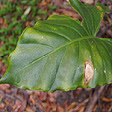 Alocasia species
Alocasia species 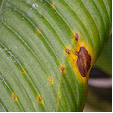
Alternaria Leaf Spot (Alternaria nelumbii) forms a small reddish brown spots that are boarded in light green, and as they develop in size the leaf curls and dies from the margin inwards. Normally occurs on Nelumbo species (water lilies).
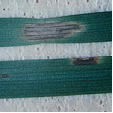 Helminthosporium Disease
Helminthosporium Disease
Helminthosporium Disease (Bipolris species), (Drechslera species) and (Exserophilum species) are responsible for several leaf spots that occur on all Turf Grass species. Generally they form black or white spots that may be faded and produce masses of spores in the thatch during late summer, under humid conditions. The life cycle is short and when conditions are favourable spores are splashed onto the foliage from the thatch, causing wide spread infection. Cynodon dactylon (common couch) is most susceptible and found in bowling or golf greens where it is a serious problem.
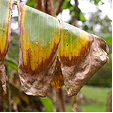 Banana Leaf Spot
Banana Leaf Spot 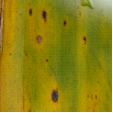
Banana Leaf Spot (Mycosphaerella musicola) is found on many species of banana causing pale yellow streaks on the young leaves to turn brown with dark spots. The leaf then becomes dried, brown and dead commencing from the margins, eventually the leaf dies. Control requires removal of infected foliage or the spraying of a fungicide and fungicides should not be used during the fruiting period.
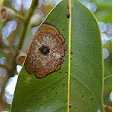
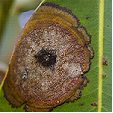 Lophostemon confertus (Brush Box)
Lophostemon confertus (Brush Box)
Leaf Spot on Brush Box (Elsinoe species). This is a casual fungus that attacks the epidermal layer of the leaf, forming circular spots that are up to 25mm across and are often restricted by the main vein. These spots are a dull yellowish brown but can also have purplish patterns. A leaf may have more than one spot develop on its surface and normally appears on scattered leaves throughout the tree. This doesn't affect the vigour of Lophostemon confertus.
Palm Leaf-scab (Graphiola phoeicis) appears as yellow spots and develop into scabs or warts that are outwards hard and dark but with a soft centre with powdery yellowish brown spores. The infected leaves eventually die.
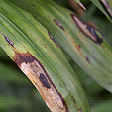 Palm Leaf Spot, Chamaedorea elegans
Palm Leaf Spot, Chamaedorea elegans
Palm Leaf Spot (Pestaloptiopsis species) appears as a small spot with a dark centre on the leaves and affects palms that are growing in shaded humid positions and normally control is not required, though infected fronds should be removed.
Source and Dispersal
Infection source is other contaminated plants and the spores are spread by wind or by splashing water. The fruiting bodies are black spots that appear on the damaged tissue releasing spores.
Favoured Conditions
This fungus prefers a warm humid environment and leafy plants with soft new growth, particularly if they are crowded.
Affected Plants
There are many ornamental and native plants that are hosts to a wide range of fungal leaf spots. Some specific ones are listed below. Plants such as Cornus or Paeonia species are infected by a large variety of leaf spots, while other plants attract a specific leaf spot.
Generally a healthy plant can tolerate fungal leaf spot attack, though it may make the plant look unsightly. In trees and shrubs it is difficult to control and generally not necessary, but in perennials and annuals control may be necessary in order to save the plant.
Acalypha and Arctotis species are infected by up to three leaf spots including (Cercospora acalyphae) and (Ramularia acalyphae) that rarely require control.
Acer species are infected by Purple Eye (Phyllosticta minima) which forms spots with brownish centres and purplish margins causing the death of the leaves.
Acer species are also infected by Tar Spot (Rhytisma acerinum) which forms round black spots that have yellow margins. Not normally seen on cultivated trees, but seen in forests.
Adiantum, Asplenium, Blechnum, Cyathea, Davallia, Nephrolepis, Platycerium, Polypodium and Pteris species are infected by the leaf spot (Pseudocercopora species) which forms circular brown spots on the fronds and heavy infection can defoliate a plant.
Aesculus species are occasionally infected with the leaf spot (Septoria hippocastani) which forms small brown spots.
Agave species are susceptible to the leaf spot (Coniothyrium concentricum), which appear as greyish spots up to 20mm (1in) across with concentric rings and black fruiting bodies. Affected leaves are destroyed as the infection spreads.
Albizia julibrissin is susceptible to the fungal leaf spot (gloeosporium aletridis), which does not normally require control.
Amelanchler, Chaenomeles, Crataegus and Rhaphiolepis species Mespilus germanica are infected by the leaf spot (Fabraea maculata) which may cause considerable damage during wet periods.
Aquilegia species can be infected by three types of Leaf Spot including (Ascochyta aquilegiae), (Cercospora aquilegiae) and (Septoria aquilegiae), normally appearing during humid conditions forming spots on the leaves.
Arbutus species are infected by two leaf spots (Septoria Unedonis) which produces small brown spots on the leaves and (Elsinoe mattirolianum).
Arctostaphylos manzanita is infected by the leave spot (Cryptostictis arbuti) which damages leaves but is not normally detrimental to the shrub.
Aspidistra species are infected by the leaf spot (Colletotrichum omnivorum) causing whitish spots on the leaves and petiole.
Aster species are infected by many leaf spots including (Alternaria species), (Cercosporella cana), ( Ovularia asteris) and (Septoria asteris).
Aucuba species are infected by several leaf spots, usually as a secondary infection after aphid attack. These include (Phyllosticta aucubae) and (Phyllostica aucubae).
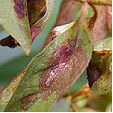
 Azalea
Azalea
Azalea (Rhododendron species) are susceptible to Leaf Scorch (Septoria azalea). This fungal disease forms reddish- brown spots which expand and engulf the leaf, with fruiting bodies appearing in the centre. Infected leaves die, then fall and the branchlets wilt. This problem is more serious during wet periods and may require control using a fungicide.
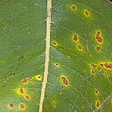 Banksia robur
Banksia robur
Banksia species are infected by several leaf spots causing chlorotic areas that have brown centres and is not normally a major problem for the plant.
Betula species may be infected by the Leaf Spots (Gloeosporium betularum) that forms brown spots with darker margins and (Cylindrosporium betulae) that also forms brown spots with faded indefinite margins.
Bougainvillea species are infected by the leaf spot (Cercosporidium bougainvilleae) which forms rounded spots with dark margins that yellowish ting. Infected leaves die and fall from the plant.
Calendula species are infected by the Leaf Spot (Cercospora calendulae) which rapidly infects the plant spotting the leaves and killing the plant.
Callicarpa species may be infected by the leaf spot (Atractilina callicarpae) forming irregular brownish spot or (Cercospora callicarpae) which can defoliate the plant in subtropical climates.
Campsis species may be infected by several fungal leaf spots including (Phyllosticta tecomae), (Septoria tecomae) and (Cercospora duplicata).
Carpinus species are infected by the leaf spots (Gloeosporium robergei), (Gnomoniella fimbriata) and (Septoria carpinea), all are minor infections not normally requiring control.
Carya species are infected by several leaf spots including (Gnomonia caryae) that infects leaves with irregular reddish spots on the upper surface with corresponding brown spore producing spots on the underside. It also has a secondary spore release that occurs on the dead leaves where it over winters. Other leaf spots include (monochaetia desmazierii) and (Marssonina juglandis).
Ceanothus species are susceptible to the leaf spot (Cercospora ceanothi) and (Phyllosticta ceanothi) both are of minor importance not requiring control.
Celtis species are infected by many leaf spots including (Cercosporella celtidis), (Cylindrosporium celtidis), (Phleospora celtidis) and (Septogloeum celtidis).
Chrysanthemums species are infected by the leaf spot (Septoria species) which forms yellow spots appear toward the edge of the leaves; these become enlarged brownish patches with yellow margins. Damaged areas may converge and in severe attacks and the leaves may fall prematurely or flower production is reduced.
Clematis species are infected by the fungal disease (Ascochyta clematidina) which may cause stem rot or leaf spots that are water soaked areas with reddish margins. The infection spreads from the leaves to the stem causing wilting and eventually girdling the stem killing the plant. There are many fungal leaf spots that infect this plant including (Cercospora rubigo) and (Septoria clematidis)
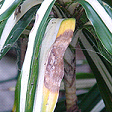 Dracaena deremensis
Dracaena deremensis
Cordyline and Dracaena species may be infected by the leaf spot (Phyllosticta maculicola) which forms small brownish spots that have yellowish margins and has black fruiting bodies that forms coils of spores. These plants are also susceptible to other leaf spots such as (Glomerella cincta) and (Phyllosticta dracaaaenae). Keep foliage dry to avoid infection.
Cynodon dactylon, Pennisetum clandestinum and many other Turf Grasses are susceptible to Helminthosporium Disease.
Daphne species are infected by the leaf spot (Gloeosporium mezerei) and (Marssonina daphnes) both of which form thickish brown spots that are seen on both sides of the leaves. Infected leaves turn yellowish before dieing.
Dendranthema species are infected by many leaf spots such as (Septoria chrysanthemi) which first forms yellowish spots up to 25mm (1in) across that become black. Infected leaves die prematurely and persist on the plant.
Dianthus species may be infected by the leaf spot (Septoria dianthi). It forms light brown rounded spots that have a purplish border. The scattered spots on the lower leaves can also be found on the stems and the spores are dispersed by water from the tiny black fruiting bodies.
Dieffenbachia species are infected by several leaf spot fungi including (Cephalosporium species) and (Myrothecium species).
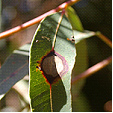 Eucalyptus species
Eucalyptus species
Eucalyptus species are infected by many fungal leaf spots such as (Mycosphaeralla species), (Hendersonia species) and (Monocheatia monochaeta). Generally leaf spots appear on the juvenile or new leaves causing brownish spots that enlarge and may have a purplish halo around the margin. Mature adult leaves are not normally infected and the trees rarely require control measures.
Fern species are infected by the leaf spot, (Alternaria polypodii). This fungus appears as brown circular or oblong spots that congregate along the margins of the pinnae causing the fronds to turn brown and die. It is spread by wind currents from plant to plant and control methods include removing infected fronds and maintaining a drier atmosphere.
Ficus species are infected by various fungal leaf spot including (Pseudocercospora species). Generally the fungal attack forms circular or irregular dark coloured spots on the leaves eventually causing them to fall prematurely.
Ficus elastica is susceptible to many fungal leaf spots including (Alternaria species), (Leptostromella elastica) and (Phyllosticta roberti).
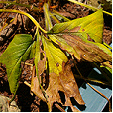
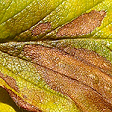 Strawberry
Strawberry
Fragaria x ananassa (Strawberry) is infected by the fungal leaf spot (Mycospharella fragariae). The mature leaf is initially infected with well defined brown spots that that turn light grey with red-purplish margins. As the spots merge they form large brown blotches and the leaf turns yellow then dies. This fungal attack normally occurs on plants in poor health and can be a serious problem early in the season seriously damaging stock.
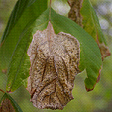 Fraxinus species
Fraxinus species
Fraxinus species are infected by the leaf spot (Gloeosporium aridum) giving the leaf a scorched appearance as large blotches appear from the margin or apex and turn brown with a papery texture. It is more prevalent during rainy periods and infected leaves fall prematurely. Collect and depose of fallen leaves otherwise control is not normally required.
Fuchsia species may be infected by the leaf spot (Septoria species) or ( Cercospora species), both form spots with dead centres and dark margins.
Gladiolus species are infected by Hard Rot or Leaf Spot (Septoria gladioli). On the corms reddish brown circular water soaked spots become large and sunken. These areas dry out and form obvious margins. The leaves may also have these symptoms but is not commonly seen.
Hemerocallis species are infected by several leaf spots including (Cercospora hemerocallis) and (Heterosporium iridis). These may be in the form of black spots or brownish spots that converge killing the leaf. Infected leaves should be removed and burnt.
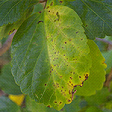 Hibiscus species
Hibiscus species
Hibiscus rosa-sinensis, Hibiscus syriacus and Hibiscus tiliaceus are susceptible to several fungal leaf spots including (Ascochyta abelmoschi), (Cerospora kellermanii) and (Phyllosticta hibiscina). All cause spotting or blotching of the leaf surface; remove and destroy infected parts.
Hydrangea species are infected by four fungal species including (Ascochyta hydrangeae), (Phyllosticta hydrangeae) and (Septoria hydrangeae).
Iris species are infected by several fungal leaf spots including (Alternaria iridicola) and (Macosphaerella species).
Iris species are also infected by the leaf spot (Didymellina macrospore) that forms greyish spots with brown water soaked borders and coalesce on the upper part of the leaf. This casual organism commonly occurs after flowering killing the leaves but will not infect the bulbs. The bulbs become weak over several seasons due to the decreased foliage.
There is also a Bacterial Leaf Spot (Bacterium tardicrescens) that is commonly mistaken as a fungal problem causing translucent spots that coalesce and involve the entire leaf. Normally found on Iris species.
Laburnum anagyroides is infected by the Leaf Spot (Phyllosticta cytisii). The leaf forms light grey spots with no definite margin and mature to brown. The black fruiting bodies appear as dots in the centre of the spot.
Leucanthemum species are infected by the leaf spot (Cerocspora chrysanthemi) and (Septoria leucanthemi).
Magnolia species are susceptible to many species including (Alternaria tenuis), (Mycosphaerella milleri) and (Phyllosticta species). Leaves generally turn brown from the apex or margins turning brown or spots appear on the leaf surface and leaves become yellow before withering and dieing. Normally the make the tree look poorly but have little effect on its growth. Control is not normally required.
Nerium oleander is susceptible to several fungal leaf spots including (Cercospora nerella), (Cercospora repens), (Gloesporium species) and (Phyllosticta nerii). Infected leaves should be removed but generally control is not required.
Nyssa sylvatica is infected by the leaf spot (Mycosphaerella nyssaecola) forming irregular purplish blotches.
Orchids such as Cattleya, Cymbidium, Cypripedium, Dendrobium, Epidendrum, Paphiopedilum, Phalaenopsis and Zygopetalum species are infected by several leaf spots including (Cerospora, Colletotrichum and Phyllosticta species). Normally forming dark or dead, circular or irregular areas on the leaves.
Palms such as Syagrus, Howea, Phoenix, Roystonea and Washingtonia species are infected by Leaf-scab (Graphiola phoeicis).
Palms such as Archontophoenix, Caryota, Chamaedorea, Cocos, Dypsis, Howea, Liculia, Linospadix, Livistona, Phoenix, Ptychosperma, Rhapis, Roystonea, Syagrus, Washingtonia and Wodyetia species are susceptible to several fungal leaf spots including;
(Bipolaris spp.), (Cylindrocladium spp.), (Colletotrichum spp.) and (Pestalotiopsis spp.).
Generally the circular leaf spots are brown and may have a yellow halo such as Palm Ring Spot (Bipolaris incurvata). They vary in size from small to large depending on the species. When a plant is healthy it recovers from attack, but heavy infections can defoliate, causing the collapse of the plant.
Palms are also infected by the Brachybasidium Leaf Spot (Brachybasidium pinangae). This fungus forms angular leaf lesions that produce fruiting bodies on the underside and is commonly found on Archontophoenix species.
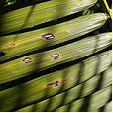
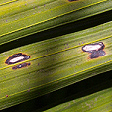 Archontophoenix cunninghamiana
Archontophoenix cunninghamiana
Passiflora species are infected with many types of leaf spot such as (Alternaria passiflorae).
Phoenix species are susceptible to False Smut (Graphiola phoenicis). This fungus forms yellow leaf spots that become hard with a raised with a blackish scab, which produces masses of powdery spores that are thread-like.
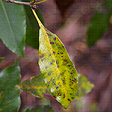
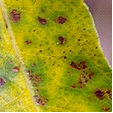 Pittosporum species
Pittosporum species
Pittosporum species are susceptible to the leaf spots (Alternaria tenuissima), (Phyllostica species) and (Cercospora pittospori). Circular or angular dark spots appear on the leaves and are surrounded by necrotic areas that are yellowish. Generally removal of infected leaves is adequate control.
Poa species and other cool season grasses are infected by Winter Fusarium Leaf Disease (Fusarium species), which causes small pale spots that are water soaked to appear on the leaves that turn red-brown. Infected leaves become bleached then wither and die, but the infection will not affect the crown or roots of the plant. It can be identified by pink, cotton-like mycelium and the plant prefers cold wet weather.
Populus species are infected by several fungal leaf spots including (Ciborinia bifrons, Ciborinia confundens), and (Mycosphaerella populicola).
Prunus species are infected by several leaf spots including (Cercospora circumscissa and Septoria ravenelii).
Pseudotsuga menziesii Douglas Fir is infected by the Leaf Cast (Rhabdocline pseudotsugae) Symptoms include the needles becoming yellowish at the apex and extending down the needle and spreading to others during moist spring weather turning them brown. Brownish scorched areas are noticeable on the tree from a distance. Control; is not normally required for mature trees but nursery stock may require spraying with a copper based fungicide.
Psidium guajava (Guava) is infected by (Glomerella cingulate). This fungus courses spots to appear on leaves and mummifies and blackens immature fruit or rots mature fruit. This fungus can devastate a guava crop.
Quercus species are infected by several types of leaf spot including (Cylindrosporium microspilum) and (Marssonina martini). These attacks tend top take place later in the season and normally not detrimental to the tree.
Rhododendron species are infected by a large variety of fungal leaf spots including (Cercospora rhododendri) and (lophodermium melaleucum)
Salix species are infected by several fungal leaf spots including (Ascochyta salicis) and (Septogloeum salicinum).
Senecio species are infected by the fungal leaf spot (Alternaria cinerariae) and (Cercospora species), forming dark rounded or angular spots.
Spiraea species are attacked by the fungal leaf spot (Cylindrosporium filipendulae).
Stenotaphrum secundatum (Buffalo) turf grass is susceptible to Grey Leaf Spot (Pyricularia grisea) in domestic and commercial situations devastating lawns. This fungal disease infects the stems and leaves with small brown lesions that enlarge rapidly forming grey-brown spots that have darker borders or surrounded by yellow chlorotic areas. This infection is commonly found on newly laid turf but will also infect established lawns. It is most prevalent during warm humid periods in soil with a high nitrogen level.
Syringa species are attacked by up to six species of leaf spot including (Cercospora lilacis) and (Phyllostica species).
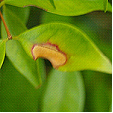 Syzygium species
Syzygium species
Syzygium species are infected by fungal leaf spots but normally control is not required.
Tagetes species are infected by the leaf spot (Septoria tageticola), which starts at the base and moves progressively up through the plant, covering the leaves in grey to black spots.
Trillium species are host to several leaf spots, including (Colletotrichum peckii) (Gloeosporium Trillii) (Heterosporium trillii).
Ulmus species are infected by many fungal leaf spots including (Gnomonia ulmea) and (Cercospora sphaeriaeformis).
Veronica species are infected by the leaf spot (Septoria veronicae). The symptoms include small violet to brown spots appear on the upper surface of the leaf and correspondingly yellowish brown on the underside. The spots converge forming a scorched shot-hole appearance and eventually death of the leaf.
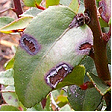 Vaccinium ovatum
Vaccinium ovatum
Vaccinium ovatum is infected by the leaf spot (Rhytisma vaccinii) and (Dothichiza caroliniana).
Vicia species are infected by the leaf spot (Erostrotheca multiformis), which forms greyish spots that enlarge and may defoliate the plant.
Wisteria species are infected by three fungal leaf spots (Phyllostica wisteriae), (Septoria wisteriae) and (Phomatospora wisteriae).
Non-chemical Control
Remove and destroy infected plant material and avoid overhead watering. When planting select infection resistant varieties. Practice crop rotation and add pot ash to the soil to decrease the plants venerability to the disease. Many species of fungus overwinter in fallen leaves, remove and destroy any litter under the plant.
Winter Fusarium Leaf Disease in Turf Grasses can be minimised by aerating the soil, reducing thatch and avoid excessive nitrogen in the soil.
Chemical Control
Protective fungicides such as zineb or copper oxychloride should be sprayed at the first sign of infection and cuttings should be sprayed as they start to grow.
Note
Always read the label for registration details and direction of use prior to application of any chemicals.
DISEASE
NAME
Root Knot & Other Nematodes
Meloidogyne & other species
Description
Root Knot Nematode or eelworms are transparent thin nematodes that are an organism up to 0.5mm long and attacks the roots by injecting saliva that stimulates the surrounding cells to form galls. The adult male lives in the soil and the female are found in the roots, laying up to 2,000 eggs in a mass in the soil adjoining the roots.
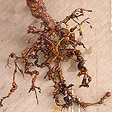
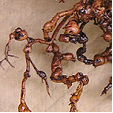
Symptoms
Above ground the plant infected by Root Knot Nematode develops slowly and is stunted. During hot weather the plant wilts easily as it is unable to keep up with the transpiration rate and under extreme conditions the plant dies. The young nematodes attack the roots forcing there way up the root tips forming galls. On inspection the galls are found centrally located along the roots and are up to 20mm across. The galls slow the rate of nutrients and water passing through the plant and as the galls break down they allow opportunity for other diseases to enter the plant.
The roots are severely damaged if the galls are physically removed.
Other species of nematode have simular symptoms and are individually discussed below.
Source and Dispersal
The nematodes are found in soil or in infested plants and are dispersed by water, soil movement and attached to tools or shoes.
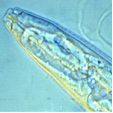 Nema Head
Nema Head
Favoured Conditions
It prefers sandy soil types and a warm moist weather conditions.
Life Cycle
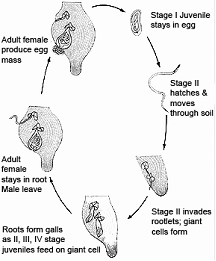
Affected Plants
A wide range of plants are attacked by the Root Knot Nematode including tomatoes, potatoes, carrots, tobacco, hibiscus, gardenia and roses. Some species of nematodes are plant specific such as (Meliodogyne incognita) which attacks Hemerocallis, Celosia and Viola species, forming small wart-like swelling on the roots.
Alternanthera, Begonia, Dianthus, Psidium, Thunbergia and Weigela species are attacked by the Root Nematode (Meloidogyne incognita). This forms small swellings on the roots causing the top growth to be stunted and not responding to improved culture. In cool climates it is found on plants in glasshouses.
Buxus species are attacked by the Meadow Nematode (Pratylenchus species) that turn the leaves a bronze colour and cause stunting of the plant. These microscopic nematodes enters through the roots and eventually result in the death of the plant.
Lagunaria patersonii is attacked by a simular nematode, the Root Burrowing Nematode (Radopholus similis) that feeds by burrowing in the outer root tissue.
Lavandula species that are grown in the northern United States are susceptible to the Peanut Root Knot Nematode (Melioidogyne hapla). Berberis species are also susceptible.
Tulipa species are attacked by Bulb and Stem Nematode (Ditylenchus dipsaci) which forms brownish streaks along the stem that may blister and may cause wilting. The flowers petals become distorted and the general vigour of the plant poor.
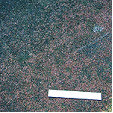
 Nematodes damage
Nematodes damage
Turf Grass are susceptible to several Parasitic Nematodes including (Helicotylenchus species), (Xiphenema Species), (Hemicycliophora species) and (Ibipora lolii). All turf grasses are susceptible and the nematodes are active from spring to autumn requiring a soil temperature 15 ºc. The leaves become chlorotic and have a weak appearance as a result of the damaged roots. Generally it is only a major problem when the nematode numbers are very high, otherwise control is not warranted.
Cultural Control
Crop rotation in infected soils, avoid using plants from the Brassicaceae family for up to four years and plant species that are tolerant of nematodes, this will reduce numbers. Beds may be laid fallow for several seasons to deter nematodes, but numbers build up quickly once susceptible plants return.
Affected plants such as roses may have the bare roots dipped in hot water 45ºC for 15 minutes during the dormant period and contaminated growing media can be heat treated at 60ºC for 30 minutes before being used.
Any infested plants should be removed and destroyed or deposed off site.
Improve the soil structure and avoid acidity by the addition of lime or dolomite. Garden beds may also be pre planted with marigolds or mustard to deter nematodes, but should be removed or thoroughly composted prior to planting as they can push nematodes towards the crop. Green manure crops may be grown prior to planting and infested soil may require up to three seasons of manure crops to bring nematodes under control.
Biological Control
The encouragement of earthworms reduces nematode numbers as they accidentally eat them in there normal course of growth.
Chemical Control
The soil can be treated with a nematicide such as fenamiphos in a domestic situation. Commercial growers may fumigate the soil prior to planting with the appropriate chemicals.
Note
Always read the label for registration details and direction of use prior to application of any chemicals.
DISEASE
NAME
Spotted Wilt Virus
Various Spotted Wilt Virus
Description
Viral problem that infects the leaves and stems of many plants.
Symptoms
Spotted Wilt Virus is a systemic disease that attacks a variety of plants with variable symptoms. In tomatoes young plants are particularly venerable, as indefinite mottling or rings first form on the upper surface of young leaves, eventually covering the leaf, causing it to shrivel and die. Stems and petioles or peduncles develop brownish streaks as the virus spreads eventually killing the young plants.
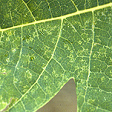 Pawpaw
Pawpaw
Older plants that are attacked produce new foliage that is mottled with bronze colouring which soon turns black causing the leaf to shrivel and die. Stems can also be affected with brown streaks and fruit of an infected plant, ripens unevenly and is marked with circular blotches. This may cause premature fruit fall.
Spotted wilt also causes plants to become stunted and for flowers to develop reddish or yellow rings.
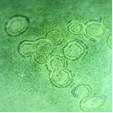 Fruit
Fruit
Source and Dispersal
The virus is found on other infected plants and is spread by thrips, particularly Onion thrips (Thrips tabaci) and Western Flower Thrips (Frankliniella schultzei). The virus may also be dispersed in infected rhizomes or tubers or nursery stock.
Favoured Conditions
Hot dry weather favours thrips activity particularly during summer, spreading the virus which appears 2 to 3 weeks later.
Affected Plants
A wide range of vegetables and ornamentals are attacked include capsicums, potatoes, broad beans and
Amaryllis, Anemone, Antirrhinum, Aster, Begonia, Calceolaria, Calendula, Chrysanthemum, Dahlia, Gerbera, Lactuca, Lathyrus, Lilium, Lycopersicon (Tomato), Nasturtium, Papaver, Pericallis, Petunia, Phlox, Schizanthus and Zinnia species.
All have simular symptoms with yellowish wavy marks that spread causing the leaf to distort turn brown and die.
Other plants such as Zephyranthes species develop yellow or parallel streaks on the leaves that spread to the stems.
Non-chemical Control
Preventative measures are important for the uninfected plants by not planting near tomato crops and the removal of weeds. The controlling of thrip infestations greatly reduces distribution of the virus.
Chemical Control
There is no chemical control of viral problems.
Average Lowest Temperature : -10º C 14º F
USDA : 2, 3, 4, 5, 6, 7, 8, 9, 10
This USDA (United States Department of Agriculture) hardiness zone chart can be used to indicate a plant’s ability to withstand average minimum temperatures. However, other factors such as soil type, pH, and moisture, drainage, humidity and exposure to sun and wind will also have a direct effect on your plant’s survival. Use this chart only as a guide, always keep the other factors in mind when deciding where, when and what to plant.
A plant's individual USDA zone can be found in the Plant Overview.
Climate Description
Cool to Cold
These zones have low winter temperatures with moderate humidity and moderate summer temperatures.
Frosts and snow are severe. Droughts rarely occur and wind is cold.
Plant growth
Endemic native and exotic cool climate plants grow well within these zones.
| Dictionary | Growth Habit |
| Leaf Type | Botanic Flower Description |
| Leaf Shape | Flower Inflorescence |
| Leaf Arrangement | Fruit Type |
| Leaf Margin | Bark Type |
| Leaf Apex And Bases | Flower Description |